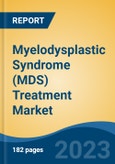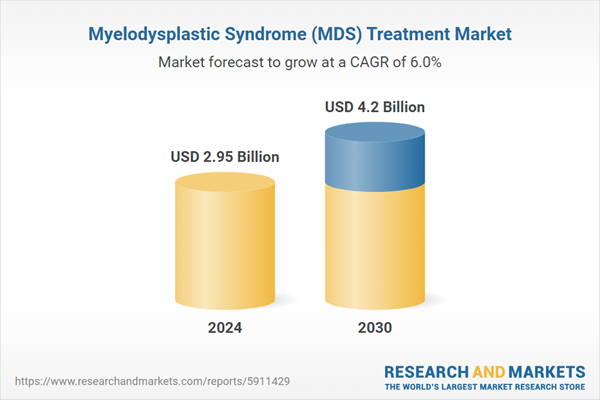Speak directly to the analyst to clarify any post sales queries you may have.
10% Free customizationThis report comes with 10% free customization, enabling you to add data that meets your specific business needs.
The Global Myelodysplastic Syndrome (MDS) Treatment Market is witnessing steady growth, driven by several factors. As the global population continues to age, the incidence of MDS is expected to rise. This demographic shift contributes to an increased demand for MDS treatments. Growing awareness among healthcare providers and patients about MDS has led to earlier diagnosis and intervention, further boosting the market's growth. Developing economies are becoming more significant players in the MDS treatment market due to improvements in healthcare infrastructure and access to advanced therapies. Continued investments in MDS research and development by pharmaceutical companies and government agencies are expected to yield innovative treatment options and expand the market.
The global Myelodysplastic Syndrome treatment market has witnessed remarkable advancements in recent years, offering new hope to patients diagnosed with this challenging condition. Targeted therapies, personalized medicine, improved supportive care, and ongoing clinical trials are transforming the landscape of MDS treatment. With a growing aging population and increasing awareness, the market for MDS treatments is poised for continued expansion, ultimately leading to better outcomes and improved quality of life for patients battling this disease.
Key Market Drivers
Rising Prevalence of Respiratory Diseases is Driving the Global Myelodysplastic Syndrome (MDS) Treatment Market
Respiratory diseases have become a significant global health concern, affecting millions of individuals worldwide. These ailments, which include conditions like asthma, chronic obstructive pulmonary disease (COPD), and bronchitis, can severely impact a person's quality of life and, in some cases, be life-threatening. The rising prevalence of respiratory diseases has led to increased demand for effective treatment options, and one such solution that has gained prominence in recent years is Myelodysplastic Syndrome (MDS) Treatment. Myelodysplastic Syndrome (MDS) Treatment are a form of medication delivery that involves inhaling a nebulized solution through a specialized device.This method is particularly effective for delivering medication directly to the respiratory system, making it a vital component in managing and treating respiratory diseases. The global Myelodysplastic Syndrome (MDS) Treatment market has witnessed significant growth in response to the increasing burden of respiratory diseases. In February 2024, Fortis Healthcare in Mumbai achieved a significant milestone, completing 100 bone marrow transplants, a key treatment for myelodysplastic syndrome, leukemia, and other blood disorders. This accomplishment, along with similar advancements and initiatives, is anticipated to drive growth in the market.
Key Market Challenges
Pricing Pressures
Pricing pressures are a significant challenge in the Myelodysplastic Syndrome (MDS) treatment market as healthcare systems across the globe implement increasingly stringent cost-containment measures. Governments, insurance companies, and payers are placing greater emphasis on cost-effectiveness and value-based healthcare, leading to heightened scrutiny of treatment costs and the value they offer.Pharmaceutical companies are under considerable pressure to demonstrate the clinical and economic value of their products in order to secure reimbursement and negotiate favorable pricing terms. In addition, these companies are tasked with finding ways to lower the overall cost of treatment for patients, including offering more affordable treatment options, exploring alternative delivery methods, or reducing the complexity and duration of therapy. The growing demand for cost-effective solutions is driving the need for innovations that deliver both clinical efficacy and economic viability, compelling drug manufacturers to focus on value-based pricing models that align with payer expectations.
Key Market Trends
Technological Advancements
Technological advancements have consistently played a pivotal role in transforming the landscape of healthcare. One such domain where this transformation is prominently visible is in the treatment of Myelodysplastic Syndrome (MDS), a group of bone marrow disorders that hinder the production of healthy blood cells. The Global Myelodysplastic Syndrome (MDS) Treatment Market is experiencing a significant boost, thanks to the remarkable strides made in technology and research. In March 2020, Gilead Sciences, Inc. and Forty-Seven, Inc. have finalized a deal in which Gilead will purchase Forty-Seven at a price of $95.50 per share in cash. Magrolimab is the primary experimental product being developed by Forty-Seven.One of the most significant breakthroughs in MDS treatment has been the ability to conduct comprehensive genetic profiling of patients. Advanced genomic sequencing technologies enable doctors to identify specific genetic mutations that drive the development of MDS. This information is crucial in tailoring personalized treatment plans and predicting disease progression accurately. With a better understanding of the genetic basis of MDS, pharmaceutical companies are developing targeted therapies that specifically address the underlying genetic abnormalities. These therapies are more effective and have fewer side effects compared to traditional chemotherapy.
Key Market Players
- AbbVie Inc.
- Accord Healthcare Limited
- Bristol-Myers Squibb Company
- Jazz Pharmaceuticals Inc.
- Novartis AG
- Lupin Limited
- Otsuka America Pharmaceutical Inc.
- Takeda Pharmaceutical Company Limited
- Astex Therapeutics Limited
- Pfizer Inc.
Report Scope:
In this report, the Global Myelodysplastic Syndrome (MDS) Treatment Market has been segmented into the following categories, in addition to the industry trends which have also been detailed below:Myelodysplastic Syndrome (MDS) Treatment Market, By Treatment Type:
- Stem Cell Transplant
- Immune Treatments
- Chemotherapy
- Immunomodulatory Drugs
- Anti-Anaemics
- Others
Myelodysplastic Syndrome (MDS) Treatment Market, By End User:
- Hospitals & Clinics
- Ambulatory Care Centers
- Others
Myelodysplastic Syndrome (MDS) Treatment Market, By Region:
- North America
- United States
- Canada
- Mexico
- Europe
- France
- United Kingdom
- Italy
- Germany
- Spain
- Asia-Pacific
- China
- India
- Japan
- Australia
- South Korea
- South America
- Brazil
- Argentina
- Colombia
- Middle East & Africa
- South Africa
- Saudi Arabia
- UAE
Competitive Landscape
Company Profiles: Detailed analysis of the major companies present in the Myelodysplastic Syndrome (MDS) Treatment Market.Available Customizations:
With the given market data, the publisher offers customizations according to a company's specific needs. The following customization options are available for the report.Company Information
- Detailed analysis and profiling of additional market players (up to five).
This product will be delivered within 1-3 business days.
Table of Contents
Companies Mentioned
- AbbVie Inc.
- Accord Healthcare Limited
- Bristol-Myers Squibb Company
- Jazz Pharmaceuticals Inc.
- Novartis AG
- Lupin Limited
- Otsuka America Pharmaceutical Inc.
- Takeda Pharmaceutical Company Limited
- Astex Therapeutics Limited
- Pfizer Inc.
Table Information
| Report Attribute | Details |
|---|---|
| No. of Pages | 185 |
| Published | February 2025 |
| Forecast Period | 2024 - 2030 |
| Estimated Market Value ( USD | $ 2.95 Billion |
| Forecasted Market Value ( USD | $ 4.2 Billion |
| Compound Annual Growth Rate | 6.0% |
| Regions Covered | Global |
| No. of Companies Mentioned | 10 |









